Glossary: Ice Cream Types & Other Frozen DessertsTerms & Definitions: A ~ FIs gelato the same as ice cream? Not exactly—it’s all about the air, or lack of it. Is sorbet the same a sorbetto? Yes, one word is French and one is Italian; but sherbet is slightly different—it adds milk. Here’s a guide to one of our favorite topics, ice cream and its close relations. This is Page 1 of a five-page glossary of ice cream types. This page includes terms such as frozen custard, French ice cream and frozen yogurt. July is National Ice Cream Month, and includes these individual days:
In Other Months:
|
|||
BAKED ALASKAA masterpiece of chemistry: ice cream, cake and meringue baked in the oven until the meringue browns. Ice cream, in a rectangle or mounded in a pie plate, is covered on all sides with slices of sponge cake or pound cake, which is then covered with meringue. The entire dessert is then placed in a 425°F oven just long enough to firm the meringue—three or four minutes. The meringue is an effective insulator, and in the short cooking time needed to finish the dessert, it prevents the ice cream from melting. The concept was developed by the Chinese, who used pastry as the insulator; a Chinese delegation introduced it to Paris in the nineteenth century. The American physicist Benjamin Thompson then investigated the heat resistance of beaten egg whites, and, in 1804, demonstrated that beaten egg whites were a better insulator. The dish was named Omelette Surprise or Omelette à la Norvégienne, the Norwegian attribution owing to the “arctic” appearance and cold center. Delmonico’s Restaurant in New York City renamed it named Baked Alaska in honor of the newly acquired Alaska territory. Make your own with this Baked Alaska recipe.
|
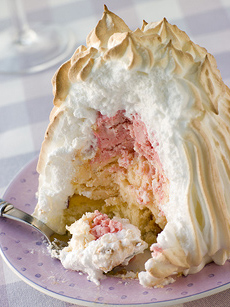 Baked Alaska. Photo by Monkey Business | Dreamstime. |
||
BANANA SPLITThe traditional banana split is a type of ice cream sundae made in a long dish called a boat (hence the alternate term, banana boat). It was invented in 1904 by David Evans Strickler, a 23-year-old apprentice pharmacist at Tassel Pharmacy in Latrobe, Pennsylvania. The sundae originally cost 10 cents, twice the price of other sundaes, and caught on with students of nearby Saint Vincent College. In those pre-digital days, news of the nifty new sundae quickly spread by word of mouth and written correspondence. It must have done well for Strickler: He went on to buy the pharmacy, renaming it Strickler’s Pharmacy. Here’s more about the banana split, including modern versions and how to throw a banana split party.
|
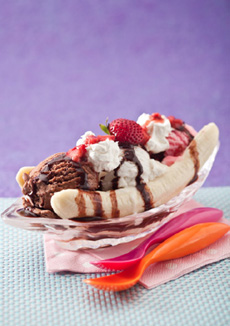 A classic banana split. Photo courtesy Wholesome Junk Food cookbook. |
||
BISCUIT TORTONI or BISQUE TORTONI or TORTONIThere’s actually a biscuit in a biscuit tortoni, typically crumbled amaretti cookies but also coconut macaroons, that are mixed into vanilla gelato. The original recipe was a custard frozen to the consistency of ice cream, flavored with rum. The top was dusted with finely chopped almonds. It is not certain if the concept originated with a late 18th-century Neapolitan, Mr. Tortoni, who opened Café Tortoni, one of the first ice cream cafés (glaciers—it operated for nearly 100 years until it closed in 1893); or if it was created elsewhere and named for the popular glacier. In modern recipes, vanilla gelato replaces the custard. In New York, the dessert, typically made in individual portions in fluted paper cups, was served at posh establishments (it was at the Waldorf Astoria in 1900). The recipe trickled down to neighborhood Italian restaurants. In the U.S., the cookie crumbs often replaced chopped almonds on top, almond extract replaced the rum in the base, and the top was garnished with a maraschino cherry.
|
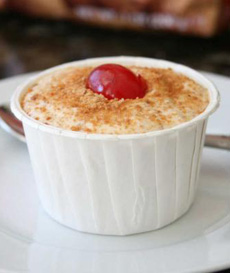 A biscuit tortoni. The biscuits are cookies crumbled inside and/or on top. Photo courtesy Sue Ade. Here’s her family recipe. |
||
BOMBEA combination of frozen parfait and ice cream, in a mold; the mold can be conventional (round, oval) or an unusual shape (flower, lobster). As with a frozen soufflé, fruit can be added, and the mixture can be molded to individual portions or large molds. It is a classic French dessert and an elegant end to a dinner. Ice cream and fruit bombes were very popular in Victorian times; the molds were often lined with cake or biscuits. CABINETA Rhode Island term for milkshake. The term may have derived from the cabinet in which the ice cream was kept; i.e., the “soda fountain” referred to the unit with the soda-dispensing spigots; the “cabinet” was a separate unit from which the ice cream was scooped.
|
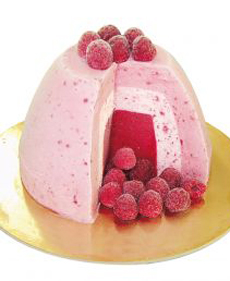 A raspberry bombe. Photo by Richard Dudley | SXC. |
||
CAKE CONE or CUP CONE or MOLDED CONEAn ice cream cone with a lighter texture, in a mold that creates a “cuff” at the top. It has less flavor than a sugar cone or a waffle cone and is generally served with less expensive ice cream. It is made in both the cup style, with a flat bottom (see photo) and with a classic tapered (pointed) bottom. CHURNINGThe process of freezing a liquid mixture in an ice cream machine to minimize crystal formation while incorporating air. |
|||
CONEA baked conical holder for ice cream. There are three main types: cake cone, sugar cone and waffle cone. |
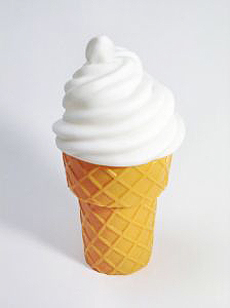 Cake cone filled with frozen custard. Photo by Jeff Prieb | SXC. |
||
CONE CUPAs opposed to the cup cone, a cake cone with a flat bottom (see above), a cone cup is a bowl made from sugar cone batter. CUSTARDShort for French custard ice cream: ice cream made richer with the addition of egg yolks, and also called Philadelphia ice cream. Do not confuse this with frozen custard or soft-serve ice cream.
|
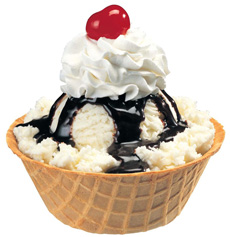 A cone cup, a.k.a. waffle cone bowl. Photo courtesy Joy Cone. |
||
FLOATAn ice cream soda, so-called because the carbonation of the soda causes the scoop of ice cream to float on the top of the drink.
|
|||
FRAPPEA New England term for milkshake, from the French frapper, “to beat.”
|
|||
FRENCH-STYLE ICE CREAM or FRENCH ICE CREAM or FRENCH CUSTARD ICE CREAMIce cream made with a custard base that includes eggs. It is richer than regular ice cream, also called Philadelphia-, New York- or American-style ice cream. See glace.
|
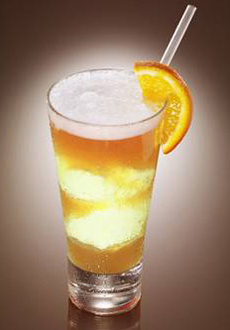 A float can be made with sorbet; for example, orange sorbet in orange soda. Photo courtesy Chocolate Box Cafe. |
||
FROZEN CUSTARD or SOFT-SERVE ICE CREAMSoft-serve is a frozen dessert similar to ice cream, but served at a warmer temperature from a machine that extrudes the ice cream into soft, swirled peaks (see photo at right). It is much lighter than ice cream, lower in milk fat and and higher in overrun—up to 60% air by volume. Frozen yogurt is also available in soft-serve form. With both ice cream and frozen custard, the ingredients are mixed at 21°F; then the ice cream goes into a hardening room where it becomes rock-solid at -40°F. Soft ice cream leaves off this last step. Frozen custard is perceived as tastier because it is warmer and doesn’t numb the taste buds. What we know today as “soft serve” or “frozen custard” and was originally regular “French” ice cream or “glace” (pronounced GLAHS). Over time, the hard ice cream became known as “French” ice cream, and “frozen custard” became the term used for the soft-serve ice creams, which did once use a custard ice cream base that included eggs.
|
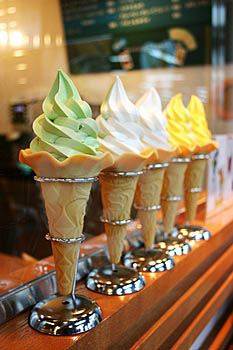 Frozen custard. Photo © Pinkcandy | Dreamstime. |
||
FROZEN SOUFFLÉA dessert that has a base, usually a cooked custard, that is lightened with whipped cream or cooked egg whites and then still-frozen in a soufflé dish in a conventional freezer. Fruit can be added, and the mixture can be molded in individual ramekins or molds or in large molds.
|
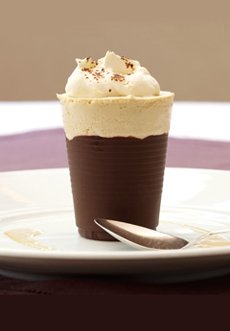 A frozen cappuccino soufflé in a chocolate cup. Get the recipe. Photo courtesy Etoile Restaurant. |
||
FROZEN YOGURTA dessert is made of lowfat or nonfat yogurt plus sweetener, gelatin, corn syrup, flavoring and sometimes, coloring. It is churned in an ice cream machine. Frozen yogurt is available soft-serve and hard-packed. It both freezes and melts much more slowly than ice cream, since yogurt has a much higher freezing and melting point than milk. The beneficial bacteria Lactobacillus bulgaricus and Streptococcus thermophilus are believed to be killed when the yogurt is frozen. If you are making frozen yogurt at home, you can use nonfat yogurt and milk in place of regular milk and yogurt in the recipes. Use a high-quality ice cream maker that can successfully freeze the mix over the longer freezing time required. Learn more about yogurt. June is National Frozen Yogurt Month; February 6th is National Frozen Yogurt Day. Have a DIY frozen yogurt sundae sundae party.
|
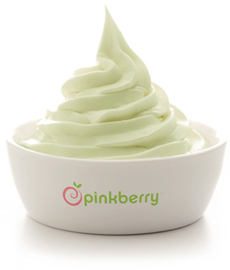 Green tea-flavored frozen yogurt. Photo courtesy Pinkberry. |
||
|
Continue To Next Page: Ice Cream Terms With G |
|||
Last Updated May 2018
© Copyright 2005-2025 Lifestyle Direct, Inc. All rights reserved. All images are copyrighted to their respective owners.